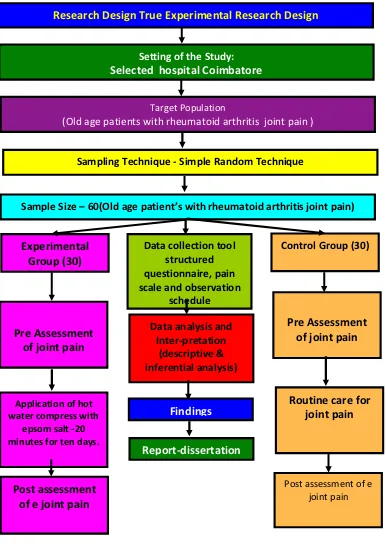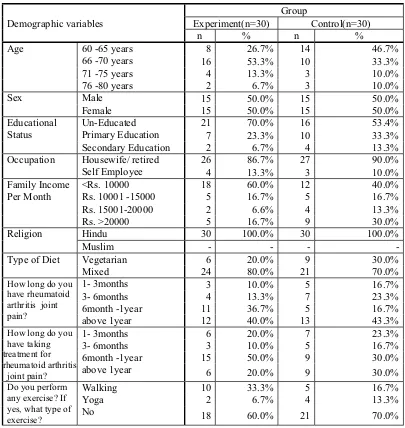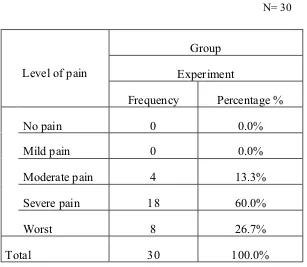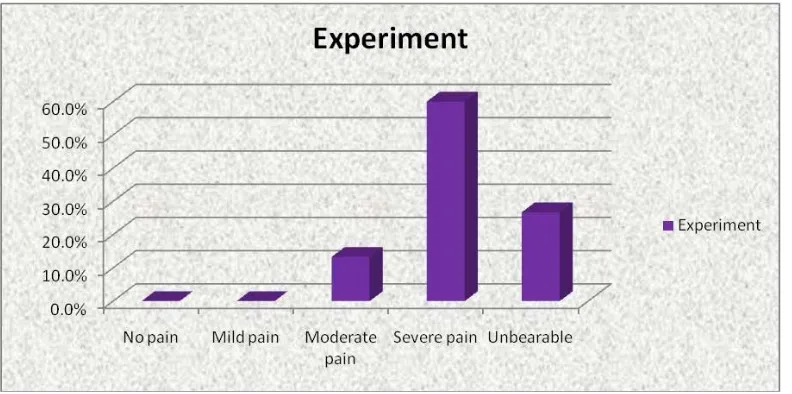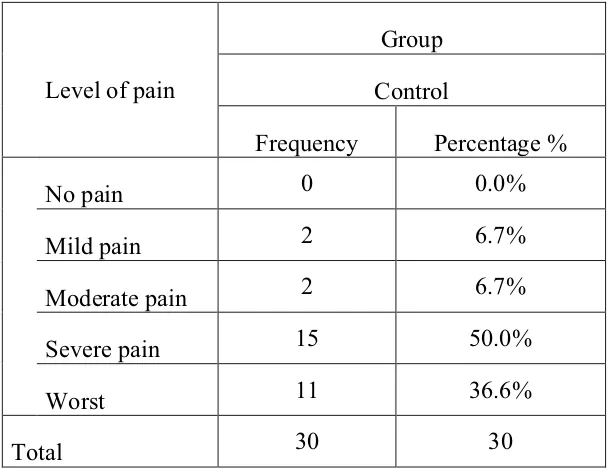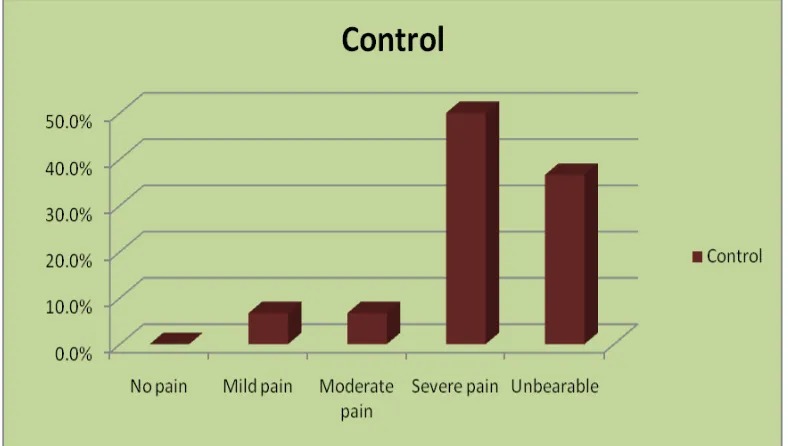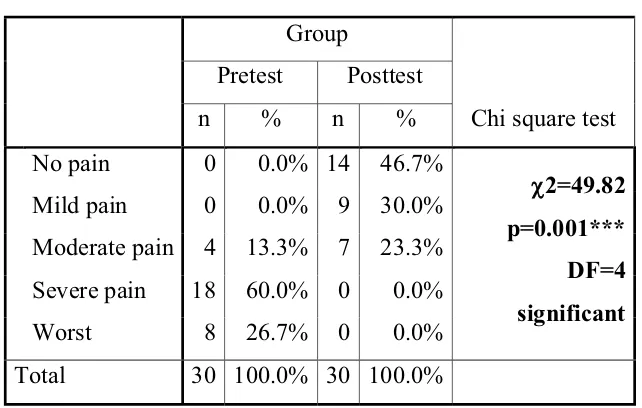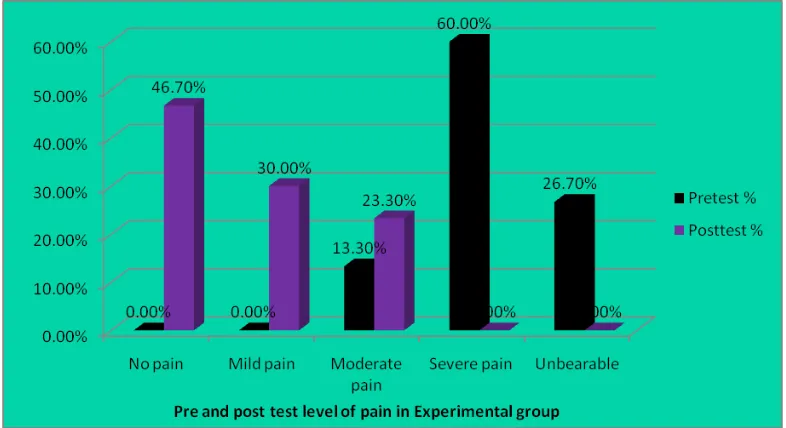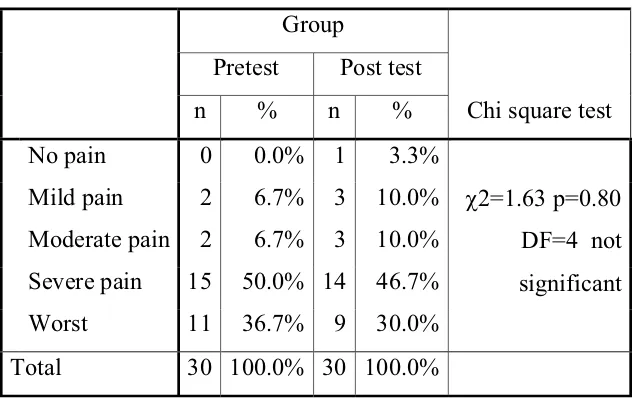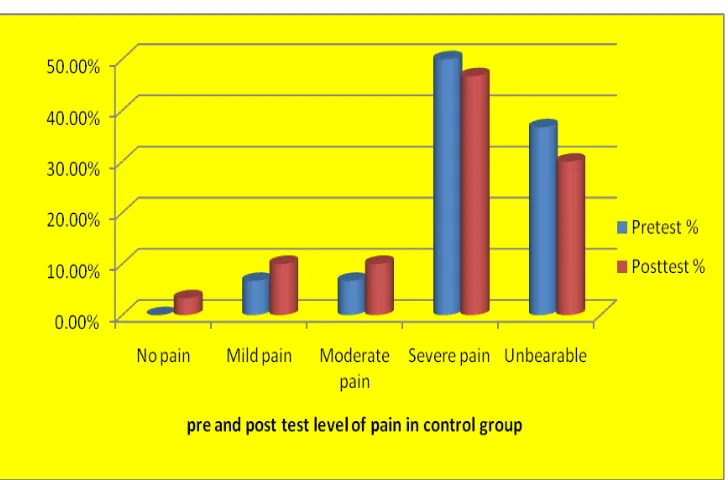A STUDY TO ASSESS THE EFFECTIVENESS OF HOT
WATER APPLICATION WITH EPSOM SALT IN REDUCING
JOINT PAIN AMONG OLD AGE PATIENTS
WITH RHEUMATOID ARTHRITIS IN A
SELECTED HOSPITAL
AT COIMBATORE
A DISSERTATION SUBMITTED TO THE TAMILNADU
DR.M.G.R. MEDICAL UNIVERSITY, CHENNAI, IN PARTIAL
FULFILLMENT OF REQUIREMENTS FOR THE DEGREE OF
A STUDY TO ASSESS THE EFFECTIVENESS OF HOT
WATER APPLICATION WITH EPSOM SALT IN REDUCING
JOINT PAIN AMONG OLD AGE PATIENTS
WITH RHEUMATOID ARTHRITIS IN A
SELECTED HOSPITAL
AT COIMBATORE
BY
RUTH BENITA .F
EXTERNAL
INTERNAL
A DISSERTATION SUBMITTED TO THE TAMILNADU
DR.M.G.R. MEDICAL UNIVERSITY, CHENNAI, IN PARTIAL
FULFILLMENT OF REQUIREMENTS FOR THE DEGREE OF
A STUDY TO ASSESS THE EFFECTIVENESS OF HOT
WATER APPLICATION WITH EPSOM SALT IN REDUCING
JOINT PAIN AMONG OLD AGE PATIENTS
WITH RHEUMATOID ARTHRITIS IN A
SELECTED HOSPITAL
AT COIMBATORE
APPROVED BY THE DISSERTATION COMMITTEE ON
RESEARCH GUIDE
CAPT.PROF.KALPANA JAYARAMAN M.SC (N),
PRINCIPAL,
ELLEN COLLEGE OF NURSING,
COIMBATORE.
CLINICAL GUIDE
COIMBATORE.
SPINE ARTHROSCOPIC & JOINT
REPLACEMENT CENTRE.
COIMBATORE.
Mr. AJAY MOSES , M.SC (N),
ASSISTANT PROFFESSOR
ELLEN COLLEGE OF NURSING,
MEDICAL EXPERT
DISSERTATION SUEBMITTED TO THE TAMILNADU
DR.M.G.R. MEDICAL UNIVERSITY, CHENNAI, IN PARTIAL
FULFILLMENT OF REQUIREMENTS FOR THE DEGREE OF
MASTER OF SCIENCE IN NURSING
APRIL 2016
CERTIFIED THAT THIS IS THE BONAFIDE WORK OF
RUTH BENITA.F
ELLEN COLLEGE OF NURSING,
COIMBATORE.
SUBMITTED IN PARTIAL FULFILLMENT OF THE REQUIREMENT
FOR THE DEGREE OF MASTER OF SCIENCE IN NURSING TO
THE TAMILNADU DR.M.G.R. MEDICAL UNIVERSITY,
CHENNAI
COLLEGE SEAL
CAPT.PROF.KALPANA JAYARAMAN, M.SC., (N),
PRINCIPAL,
ACKNOWLEDGEMENT
The satisfaction and pleasure that accompany the successful completion of any task would be incomplete without mentioning the people who have made it possible and whose constant guidance, support and encouragement has brought me this far. I consider it as a privilege to express my Gratitude and Respect to all those who have guided me in the completion of this Study.
I express my deep sense of Gratitude to the Lord Almighty for the blessing which has enabled me to complete this study.
I extend my profound and a deep sense of Gratitude to my study participants who extended their co-operation throughout the study period, without their co-operation and Participations it would have been impossible to conduct the study.
I honestly express my sincere Thanks to DR. A. GUNA SINGH EMMANUEL MA, BL,. , PH.D., Correspondent of our college, for all the facilities, he had provided and giving me an opportunity to study in this esteemed institution.
I am Thankful to my most Respectful Administrative Officer MRS. JASMINE GUNASINGH to support and encourage to achieve the goal.
I would like to convey my heartfelt gratitude to our PRINCIPAL CAPT. PROF. KALPANA JAYARAMAN, MSC (N), Ellen College of Nursing, Coimbatore, whose excellent guidance, expert suggestion, encouragement and support has helped me to tide over.
I extend my sincere thanks to PROF. MRS. S. SUSILAKUMARI M.SC (N) VICE PRINCIPAL, Head of the Department of Mental Health Nursing, Ellen College of nursing, for the constant supervision and guidance in completion of my study the hardships encountered during the study.
I owe my sincere Thanks to Research Guide, M. Sc (N). Ellen College of Nursing, for her Excellent and timely guidance and support.
expert suggestion, encouragement and support that helped me to tide over the hardships encountered during the study.
I am obligedto Mr. A.VENGATESAN M .Sc
Statistician,
for his invaluable suggestion and guidance regarding application of proper statistical methods.I proudly express my sincere thanks to Prof. G. MAHALAKSHMI M. Sc (N).,
Principal Royal College of Nursing, Coimbatore, for her inspiring guidance
constructive suggestions and constant encouragement throughout the research study to make this project fruitful learning experience.
It is my most pleasant time to express my profound gratitude and exclusive thanks to my beloved class coordinator & Assistant Professor, MRS. P. AKILA M.SC (N), for her valuable suggestion, guidance, support and encouragement to achieve this goal.
My Special thanks to our M. Sc (N) faculty Mrs. SHERINE JEBA PRIYA, M. Sc (N)., for their scholarly guidance, valuable suggestions, precise advice, inspiration and encouragement which made the study purposeful.
I also record my respect and tribute to the librarian Ellen College of Nursing, for allowing me a free hand into the library.
My sincere thanks and gratitude to all my patients for their endurance and support. My friend MRS. S. VIMALA M.SC (N), Who dedicated her valuable, time to guide and to support me to submit this thesis.
Words are inadequate to express the affection, inspiration and devotion shown by my beloved husband MR. QUBERT THAMBI RAJ my beloved daughter & son
DEBORAH GLORIANE &DAVID SHERWIN for their unending words of encouragement and constant support throughout this study.
A special thanks to my friends and all well wishers who had helped me to complete
ABSTRACT
Pain is a multi dimensional phenomenon. Management of pain includes pharmacological and non pharmacological approaches. Rheumatoid arthritis is a chronic, systemic inflammatory disorder that may affect many tissues & organs but principally attacks the joints produce an inflammatory synovitis that often progresses to destruction of articular cartilage and ankylosis of the joints. The researcher found that the hot water application is very effective in relieving pain in the joints. Hence the Researcher planned to conduct a study to assess the effectiveness of hot water application with Epsom salt in reducing joint pain among old age patients with Rheumatoid arthritis in a selected hospital at Coimbatore.
Objectives of the study
x To assess the level of joint pain among old age patients with rheumatoid arthritis in experimental and control group.
x To evaluate the effectiveness of hot water compress with Epsom salt in reducing joint pain among old age patients with rheumatoid arthritis in experimental and control group.
x To determine the association between degree of joint pain and selected demographic variables of old age patients with Rheumatoid arthritis in experimental and control group
The major findings of the study were,
mean post test level of rheumatoid arthritis pain among old age in experimental group was significantly lower than the mean post test level of pain among old age patients in control group (t=10.95 p=0.001)
There was a significant difference between pre and post-test level of arthritis pain score among old age patients in experimental group. ( t value = 10.95, p= 0.001 at p<0.05 level of significance.
The association between pain reduction score and patients demographic variables. Elders (F2=7.76, p=0.05), more educated (F2=7.90p=0.05*), less duration of pain (F2=9.14 p=0.03*) and exercise (F2=9.16 p=0.01*) patients had more reduced pain than others.
CONCLUSION
LIST OF CONTENTS
CHAPTER CONTENT PAGE
NO
I INTRODUCTION
1
¾
Need for the study
3
¾
Statement of the problem
6
¾
Objectives of the study
6
¾
Hypothesis
6
¾
Operational definitions
7
¾
Assumptions 8
¾
Delimitation
8
¾
Projected outcome
8
II
REVIEW OF LITERATURE
9
Review of Literature
9
¾
Review of literature related to Rheumatoid
Arthritis joint pain in old age
¾
Review of literature related to the effectiveness
of hot water application and joint pain.
¾
Review of literature related to the effectiveness
of Epsom salt, hot application
10
12
16
Conceptual framework
17
III RESEARCH
METHODOLOGY
21
¾
Research Approach
21
¾
Research design
21
¾
Variables 22
¾
Setting of the study
22
¾
Study population
22
¾
Sample 22
¾
Sampling technique
22
¾
Criteria for selection of sample
22
¾
Inclusion criteria
22
¾
Exclusion criteria
23
¾
Development and description of tool
23
¾
Content Validity
24
¾
Reliability of the tool
24
¾
Pilot study
24
¾
Data collection procedure
25
¾
Plan for data collection
26
¾
Ethical Consideration
26
¾
Schematic Representation of Research
Methodology
27
IV
DATA ANALYSIS AND
INTERPRETATION
28
V DISCUSSION
49
VI
SUMMARY, CONCLUSION AND
RECOMMENDATION
47
¾
Summary 51
¾
Major findings of the study
49
¾
Conclusion 57
¾
Implications
of the
study
x
Nursing Practice
57
x
Nursing Education
57
x
Nursing Administration
58
x
Nursing Research
58
¾
Limitation 58
¾
Recommendations 59
LIST OF TABLES
TABLE
NO
TITLE
Page
No
1.
Frequency and percentage distribution of demographic variables among old age patients with rheumatoid Arthritis joint pain in
relation to their selected demographic variables
30
2.
Frequency and Percentage Distribution of pre-test level of pain among patients with Rheumatoid Arthritis joint pain in
experimental group.
32
3.
Frequency and Percentage Distribution of pre-test level of
Rheumatoid Arthritis joint pain among ROGDJHSDWLHQW¶Vin control
group.
34
4.
Frequency and percentage distribution of pre-test and post-test level of joint pain score among Rheumatoid Arthritis old age
patients with Rheumatoid Arthritis in experimental group.
36
5.
Distribution of pre-test and post-test level of pain among old age
patients in Control group..
38
6.
0HDQ6WDQGDUG'HYLDWLRQDQG³W´ value of pre and post-test level
of pain among old age patients in experimental group.
40
7.
Mean, Standard Deviation And ³t´9DOXH2I3UH$QG3RVW-Test
Level Of Pain Among Old Age Patients In Control Group.
42
8.
0HDQ6WDQGDUG'HYLDWLRQDQG³t´9DOXH2I3UH$QG3RVW-Test Level Of Pain Among Old Age Patients In Experimental And Control Group..
44
9.
Association of post-test level of rheumatoid arthritis joint pain
in experimental group.
10.
Association Between Pain Reduction Score And Patients Demographic Variables (Control Group )
LIST OF FIGURES
TABLE
NO
TITLE
Page
No
1.
Conceptual frame work
20
2.
Schematic representation of
Research design.21
3.
Pre-test level of pain among patients with Rheumatoid
Arthritis joint pain in experimental group.
33
4.
Pre-test level of pain among patients with Rheumatoid
Arthritis joint pain in control group.
35
5.
Comparison of Pre and Post Test level of pain among
experimental group.
37
6.
Comparison of Pre and Post Test level of pain among
experimental group.
39
7.
Comparison of Pre and Post Test mean pain score
among
experimental group.41
8.
Comparison of Pre and Post Test mean pain score
among control
group43
9.
Mean difference value between experimental group and
LIST OF APPENDICES
TABLE
NO
TITLE
A.
Letter seeking permission for conducting the studyB.
Letter seeking experts opinion for content validity of the toolC.
List of experts for content validityD.
Tool validation letterE.
Informed consentF.
Copy of the toolG.
Scoring procedureAPPENDIX- A
LETTER SEEKING AND GRANTING PERMISSION FOR CONDUCTING
APPENDIX-B
APPENDIX ± C
LIST OF EXPERTS FOR CONTENT VALIDITY
MEDICAL EXPERTS
1. Dr. DAVID V. RAJAN MS.(Ortho)M.N.A.M.S.(Ortho) F.R.C.S.(G)
SPINE ARTHROSCOPIC & JOINT REPLACEMENT CENTRE.
COIMBATORE.
2. DR.P ARULRAJ ,MS.,DNB.,MNAMS.MRCS( Edin)
GKNM Hospital
COIMBATORE
3. A.B GOVINDARAJ
ORTHOPAEDIC SURGEON
FORTIS MALAR HOSPITAL
CHENNAI
NURSING EXPERTS
1. MRS.ARUNA., M.SC(N)
HEAD OF THE DEPARTMENT
MEDICAL SURGICAL NURSING
SAVEETHA COLLEGE OF NURSING,
CHENNAI
2. MRS. RATHNA KUMARI M.SC (N)
ASST.PROFESSOR,
A.C.S COLLEGE OF NURSING,
4.R. KAVITHA ELIZABETH M.SC (N)
5. VICTOR DEVA ASHIRVADAM M.SC (N) , Ph.D.
PROFFESSOR
V.P.M.M COLLAGE OF NURSING V.P.M NAGAR
VIRUDHUNAGAR TAMILNADU
PROFFESSOR
V.P.M.M COLLAGE OF NURSING V.P.M NAGAR
APPENDIX ± C
APPENDIX ± E
INFORMED CONSENT
Respected Madam,
I Mrs. Ruth Benita .F IIndYear, M.Sc. (Nursing) student from Ellen College of Nursing, Navakkarai
, Coimbatore is Conducting ³$ VWXG\ WR DVVHVV WKH HIIHFWLYHQHVV RI KRW ZDWHU application with Epsom salt in reducing joint pain among old age patients with
5KHXPDWRLG DUWKULWLV LQ D VHOHFWHG KRVSLWDO DW &RLPEDWRUH´. I request your co
RSHUDWLRQWRFRPSOHWHP\UHVHDUFK,DVVXUH\RXWKDW\RXZRQ¶WJHWDQ\KDUPGXHWRWKH
research.
I am MR./Mrs««««««««««««,KHDUGDERXWWKHeffectiveness of hot water application with Epsom salt in reducing joint pain among old age patients with Rheumatoid arthritis from Ruth Benita .F .She explained me about the benefits of this intervention. I agree with this intervention of hot water application with Epsom salt in reducing joint pain whole heartedly.
Yours
Sincerely,
Place:
APPENDIX F
APPENDIX G
COPY OF THE TOOL
APPENDIX H
APPENDIX
±
I
INTERVENTION GUIDE FOR HOT WATER APPLICATION WITH EPSOM
SALT FOR OLD AGE PATIENTS WITH RHEUMATOID ARTHRITIS JOINT
PAIN
INTRODUCTION
As a part of my research study intervention chosen for the study was hot water application with Epsom salt.
PRELIMINARIES
Assess the patients knowledge regarding hot water application and joint pain
Explain the procedure and its effect on Old age patients with joint pain
Check the joint pain by using Numeric Pain Intensity scale
Explain the benefits of hot water application with Epsom salt
PROCEDURE
Explain the procedure to patients
Get consent from them.
Epsom salt compress was prepared by adding 30 grams of Epsom salts to one liter of boiling water
(The temperature of the boiling water was as tolerated by the client) creating a hot compress by dipping a clean washcloth in the boiling water, wringing it out,
Applying for 20 minutes over the joint in which pain was present, twice a
.
POST TEST
1
CHAPTER-1
INTRODUCTION
A man too busy to take care of his health is like a mechanic too busy to take care of his tools. - Spanish Proverb
"If you can go through life without experiencing pain, you probably haven't been
born yet." -Neil Simon
Pain is defined as an unpleasant sensation occurring in varying degrees of severity as a consequence of injury, disease, or emotional disorder. But the pain is more than unpleasant sensations. Pain is a major component part of your nervous system. Pain is ultimately a perception, and a bodily state. Despite its unpleasantness, pain is a critical component of the body's defense system. It is part of a rapid warming and defense relay instructing the motor neurons of the central nervous system to minimize detected physical harm.
Rheumatoid arthritis is a chronic, systemic inflammatory disorder that may affect many tissues & organs but principally attacks the joints produce an inflammatory synovitis that often progresses to destruction of articular cartilage and ankylosis of the joints. It also produces diffuse inflammation in lungs, pericardium, pleura & sclera.
$ERXWRIWKHZRUOG¶VSRSXODWLRQLVDIIOLFWHG by rheumatoid arthritis, women three times more often than men. Onset is more frequent between the ages of 40 and 50.It can be disabling and painful, which can lead to substantial loss of functioning and mobility.
2
more than 100 distinct conditions and can affect people at any stage of life. Two of the most common forms are osteoarthritis and rheumatoid arthritis.
Some complications of arthritis include joint stiffness, social complications, reduced physical activity, reduced leisure activity etc. Joint pain due to arthritis can limit sexual activity. Rheumatoid arthritis affects the quality of the life. The complications of Rheumatoid arthritis include joint distraction, heart failure, lung disease, low or high platelets, spine instability etc. Affected joints may worsen the ordinary tasks of the day to day life. Rheumatoid arthritis complications of this disease may shorten survival in some individuals.
Pain too is part of the body's defense system, it triggers mental problem solving strategies that seek to end the painful experience. Pain intensity may range from slight through severe to agonizing; it is experienced as having qualities such as sharp, throbbing, dull, nauseating, burning and shooting. It often has both an emotional quality and a sensed bodily location.
Pain can be classified as acute or chronic. The distinction between acute and chronic is not based on its duration of the sensation, but rather of the pain itself. The primary distinction is that an acute pain serves to protect one, e.g. After an injury. Whereas chronic pain does not serve this or any other purpose and is the diseases of pain.
Joint pain is a common musculoskeletal disorder affecting 80% of people at some point in their lives. In India it is the most common cause of job related disability and the second most common neurological ailment- only headache in more common. It can be either acute, sub acute (or) chronic in duration. With conservative measures, the symptoms of joint pain typically show significant improvement within a few weeks of onset.
3
examination, no specific cause of the pain can be identified. America spends approximately $50 billion a year on joint pain.
Although there is no known cure for most forms of arthritis, treatment designed for individual patient can reduce/eliminate symptoms and limit functional impairment. The goals of contemporary management of arthritis extend beyond pain
FRQWURO WR WKH HQKDQFHPHQW RI SDWLHQWV¶ IXQFWLRQDO VWDWXV DQG KHDOWK-related quality of life. Patient education regarding joint protection and avoidance of excessive joint loading is important for this patient. Physical measures like hot pack, paraffin bath or occupational therapies may be helpful.
Complementary and alternative medicine (CAM) has been defined by the
1DWLRQDO &HQWHU IRU &RPSOHPHQWDU\ DQG $OWHUQDWLYH 0HGLFLQH DV ³D JURXS RI GLYHUVH
medical and healthcare systems, practices, and products that are not presently considered to be part of conventional medicine´For some CAM practices, there is scientific evidence that a treatment is both beneficial and safe. Most patients who use complementary and alternative medicine treatments were not dissatisfied with conventional or established medical treatments but find that complementary medicine appeals to their values and beliefs about health.
The medical surgical nursing, one of the major branch of dealing with all the adult health problems. Most of the adult health problem manifested through pain .The article 2008 reported especially the pain is the major symptom of most musculoskeletal disorders. The pain may be mild or severe, local or diffuse, depending on where the injury occurred. Although pain may be acute and short-lived, as is the case with most injuries, pain may be ongoing with chronic illnesses, such as arthritis.
NEED FOR THE STUDY
'The art of life is the art of avoiding pain" -William Hazlin
4
NSAIDs are also useful but the drugs have severe side effects. Instead of using their drugs home remedies can be practice which is effective and safe.
Srivastava in 2007 reported that the old age (people above the age of 60 years)
FRPSULVHSHUFHQWRI,QGLD¶VWRWDOSRSXODWLRQDQGPDNLQJKHDOWKFDUHDYDLODEOHDQG
accessible to them is one of the health priorities of the country.
The prevalence of rheumatoid arthritis was studied in the adult Indian population. As the first step, a house-to-house survey of a rural population near Delhi was conducted by two trained health workers. The target population comprised 44,551 adults (over 16 years old). The health workers identified the possible cases of rheumatoid arthritis (RA) using a questionnaire. These cases were then further evaluated by the authors using the 1987 revised ARA [Acute Rheumatoid Arthritis] criteria for the diagnosis of RA. A response rate of 89.5% was obtained and 3393 persons were listed as possible cases of RA by the health workers. Of these, 299 satisfied the revised ARA criteria for the diagnosis of RA, giving a prevalence of 0.75%. Projected to the whole population, this would give a total of about seven million patients in India.
According to the findings of the 60th National Sample Survey Round in 2006 reported that, the proportion of age, persons who cannot move and are confined to their bed or home ranges from 77 per 1000 in urban areas to 84 per 1000 in rural areas Morbidity7. It is currently estimated that adults over 60 years make up 8 per cent of India's population and by 2021 that number will be 137 million. India now has the second largest aged population in the world. The small-family norm means that fewer working, younger individuals is called upon to care for an increasing number of economically unproductive, old age persons. In India 75% population living in the rural areas.
5
Most people don't get enough magnesium, which can affect their nerve, muscle and enzyme function, ultimately contributing to pain and inflammation that can affect your back, and according to the Epsom Salt Council. Soaking in Epsom salt is one of the best ways to get its benefits, since your body doesn't process ingested magnesium as efficiently as it does absorb magnesium.
On the physical side, Epsom salt, which is the mineral magnesium sulfate, has been found to help alleviate pain. Additionally, soaking in an Epsom Salt and Epsom salt compress helps to pull toxins from the body, which speeds the healing process. When a cold or the flu is coming on, adding Epsom Salt to a before-bed bath can often stop the virus in its track.
Doctors usually refer to joint pain is as acute if it has been presence for less than a month and chronic if it fasts for a longer period of time. Joint pain is one of the most common medical problems affecting 8 out of 10 people at some point during their lives. Joint pain can range from a dull, constant ache to a sudden, sharp pain.
The study conducted by Brosseau L, Yonge KA, Robinson V et.al in 2003 to determine the effectiveness of thermotherapy in the treatment of OA of the Joints. The outcomes of interest were relief of pain, reduction of edema, and improvement of flexion or range of motion (ROM) and function. The results shows that three randomized controlled trials, involving 179 patients, were included in this review. In one trial, administration of 20 minutes of ice massage, 5 days per week, for 3 weeks, compared to control demonstrated a clinically important benefit for OA on increasing quadriceps strength (29% relative difference) and another trail with hot application. There was also a statistically significant improvement. Result showed that cold packs decreased edema. The thermotherapy reduces the pain. The study concluded that more well designed studies with a standardized protocol and adequate number of subjects is needed to evaluate the effect of thermotherapy in the treatment of OA of the Joints.
6
In the hot water application for the joint pain is Epsom salt hot water bath very effective in the treatment of joint pain. Epsom salt can act topically and immediately reduce the pain in joint. The 200 mg of Epsom salt mixed in hot water the painful joints can be bathed for 20 mins .It can be used for thrice a week. It is very effective to relieve morning stiffness in joints (html- Cached- Sim updated 2006)
From the above review and by the researcher's own observation, the researcher found that the hot water application is very effective in relieving pain in the joints. Few studies supporting the benefit of Epsom salt hot water application. In this study the investigator planned to conduct the study to evaluate the effectiveness of hot water application with Epsom salt for reducing joint pain in old age patients.
STATEMENT OF THE PROBLEM
³A study to assess the effectiveness of hot water application with Epsom salt in reducing joint pain among old age patients with Rheumatoid arthritis in a
selected hospital at Coimbatore´.
OBJECTIVES OF THE STUDY
x To assess the level of joint pain among old age patients with rheumatoid arthritis in experimental and control group.
x To evaluate the effectiveness of hot water compress with Epsom salt in reducing joint pain among old age patients with rheumatoid arthritis in experimental and control group.
x To determine the association between degree of joint pain and selected demographic variables of old age patients with Rheumatoid arthritis in experimental and control group
HYPOTHESIS
7
x H2: There will be a significant difference between the mean pre and post -test level of joint pain score among old age patients with Rheumatoid arthritis in control group.
x H3: There will be a significant difference between the mean post-test level of joint pain score among old age patients with Rheumatoid arthritis in experimental and control group.
x H4: There will be a significant association between the post-test level of joint pain score among old age patients with Rheumatoid arthritis in with their selected demographic variables in experimental and control group.
OPERATIONAL DEFINITIONS
x Assess: It is the organized, systematic and continuous process of collecting data from the old age patient regarding the level of joint pain.
x Effectiveness: Outcome of the intervention measured with a numerical pain scale.
x Hot Water compress: Applying the heat at localized areas, which produce the physiological change in the body, such as vasodilatation and relaxation of muscles which produce the beneficial therapeutic effect of relieving the joint pain.
x Hot Water application with Epsom Salt: Epsom salt is the one of the home remedy which is rich in magnesium. This is very helpful for relieving the joint pain.
x Rheumatoid arthritis - Rheumatoid Arthritis [RA] is the most common form of autoimmune arthritis, discomfort of the joints due to stiffness of the joint, tendons, ligaments and muscles.
x Joint Pain: Joint Pain due to RA is a chronic (long-term) disease that causes pain, stiffness, swelling and limited motion and function of many joints. While RA can affect any joint, the small joints in the hands and feet tend to be involved most often. Inflammation sometimes can affect organs as well, for instance, the eyes or lungs..
8
ASSUMPTION
1. Hot application relieves pain, inflammation and congestion. 2. Epsom salt has analgesic properties.
3. Epsom salt easy to avail low cost
4. Reducing the pain and Meeting the comfort needs of the old age patients is an important function of a nurse.
DELIMITATIONS
¾ The study was delimited to the old age patients who were suffering with Rheumatoid Arthritis joint pain
¾ The study was limited to small sample size. The samples taken were only 30 for the experimental group and 30 for the control group
PROJECTED OUTCOMES
x The study will help the nurses to assess the level of Rheumatoid Arthritis joint pain reduction experienced by the ROGDJHSDWLHQW¶V with after the hot water application with Epsom salt.
x The study will help the nurses to assess the effectiveness of Epsom salt in reducing Rheumatoid Arthritis joint pain.
9
CHAPTER II
REVIEW OF LITERATURE
³$JUHDWOLWHUDWXUHLVFKLHIO\WKHSURGXFWRILQTXLULQJPLQGVLQUHYROWDJDLQVWWKH
LPPRYDEOHFHUWDLQWLHVRIWKHQRWLRQ´
- H.L. Mencken $FFRUGLQJ WR 3ROLW DQG +XQJODU WKH OLWHUDWXUH UHYLHZ LV GHILQHG DV ³D FULWLFDO
summary of research on a topic of interest often prepared to put a research problem in cRQWH[W´/LWHUDWXUe review helps to lay the foundations for the study. It provides the background for understanding the current knowledge on Illustration the significance of the new study.The investigator assembles knowledge by reviewing the literature of a selected problem and is presented under the following headings.
x Section A: Review of literature related to rheumatoid arthritis joint pain in old age
x Section B: Review of literature related to the effectiveness of hot water application and joint pain.
x Section C: Review of literature related to the effectiveness of Epsom salt, hot application
Section A:Review of literatureStudies related to rheumatoid arthritis joint pain
in old age
10
programmes and of running trainings, talks aiming at increasing knowledge on rheumatoid arthritis among patients.
Elly M Van Der Wardt.et.al. (2011) conducted a study to gain insight into the general public's knowledge and perceptions regarding rheumatic diseases in the Netherlands. A questionnaire was sent by mail to a random sample of 1800 Dutch homes; the response was 658. Questions mainly focused on knowledge, attitudes, behavioural intentions and use of the mass media with regard to rheumatic diseases. The respondents gave the right answer to a mean of 8.2 statements out of 17 true/false statements regarding factual knowledge of rheumatic diseases. Respondents particularly were unaware of several rheumatic disorders. Thus the study concluded that the public in general do not know very much about rheumatic diseases.
Lena, et al. (2009) conducted a cross-sectional study on problems among 231 elders in Udupi Taluk, Karnataka. The result of the study showed that a majority of them had problems such as hypertension followed by arthritis, diabetes, asthma, cataract, and anemia. Among them, 68% of the patients suffered with joint pain. Joint pain was found to be more common among female.A survey conducted by the investigator in the Anderson pet village, Chennai (2009) showed the total number of old age people as 160, among them 90% reported joint pain in either one or both joints.
Thyberg I et.al., (2009) conducted a cross-sectional study of health and social problems among two hundred and seventy-six old age patients, 191 women and 85 men, with early rheumatoid arthritis were included. Aliments were examined with respect to 28-joint count disease activity score, and disability variables reflecting pain, sleep disturbance, fatigue, mental health, and activity limitation, at follow-ups at 1, 2 and 3 years after diagnosis. Among them 80% reported joint pain in either one or both joints.
11
Men'shikova IV, Babyre VV. (2008); conducted a cross-sectional study. The study included 214patients aged from 35 to 85 years with a pain level of at least 40 mm by the visual analog scale (VAS).The results of the physical and X-ray examination provided indications for further studies that were performed by ultrasonographic (40.1%), arthroscopic (52.3%), and MRT (64.2%) techniques. One third of the patients were aged women with the body mass index > 40.1 and stage 3 osteoarthrosis (OA) in whom pain was attributable to primary osteoarthritis. The remaining patients had pain of other origin. There was excellent (98.6%) agreement between MRT diagnosis and arthroscopic data on licensed intra-articular structures, articular cartilage, and subchondral bone. Arthroscopy revealed traumatic and degenerative meniscal tear in 85% patients, injured anterior cruciate ligament in 8%, signs of sinusitis in 52.6%, chondromalacia of the femoral condyle in 57.6%, and isolated pathology of patellofemoral articulation in 33% of the patients.
Rishmaki (2008) conducted a study on physical exercise and risk of severe OA related joint pain requiring arthroplasty. The study result showed that, both in the men and women, the risk was less in those with higher numbers of cumulative hours of exercise than with those who had no regular physical exercise. The association was significant (p< 0.05). The study concluded that moderate recreational physical exercise is associated with a decrease in the risk of OA related joint pain.
12
Bhatia & Verma (2007) conducted an epidemiological study in correlated joint pain in 362 old age people aged more than 65 years in the urban and rural areas of Chandigarh, India. The study revealed that the overall prevalence of joint pain among old age as 56.6% in rural areas, it was 32.6% and in urban it was 60.3%. Joint pain was more in females compared to males (70.1% Vs 41.6%).
Section B :Review of literature related to hot water application and joint pain
Yildirim , N., Filiz Ulusoy, M., & Bodur, H. ( 2010) conducted a study to evaluate the effect of heat application on pain, stiffness, physical function and quality of rheumatoid Arthritis the faculty of health sciences, Midwifery department, Cumhuriyet university, turkey. The intervention group received 20 minute heat application every day for four weeks in addition to routine medication. It was found that heat application decreased pain and disability of the patients with rheumatoid arthritis. Heat application was found to improve the sub dimensions of quality of life scores of physical function, pain and general health perception of patients.
Kirk, J.A., & Kersley, G.D. (2009) studied the effectiveness of heat in the physical treatment of rheumatoid arthritis of at Royal national 19 hospitals for rheumatic diseases. Hot packs were given for 20 minutes with temperatures approximately 45 degrees C at the beginning and at the end 41 degree C. Results showed that greater relief from pain and stiffness due to hot application.
Lehmann, JF., Warren, CG., & Scham, SM. ( 2009) conducted a study to assess the therapeutic effect of heat on rheumatoid arthritis. Patients received heat application to affected joint. Hot application had an effect on pain and relieving stiffness. Patients preferred heat therapy. The researcher concluded that superficial heat can be applied to chronic pain management.
13
Chou, R., Huffman, LH. ( 2007) conducted a meta-analysis of studies of non ± pharmacological therapies for chronic pain in rheumatoid arthritis: a review of the evidence for an American pain society, American college of physicians. They found good evidence that the only non pharmacological therapies with evidence to reduce pain or superficial heat application
Parminder Kaur, et.al.,(2007) conducted a study to assess the effect of
µPRLVWKHDWDSSOLFDWLRQ¶ RQWKHLQWHQVLW\RI joint pain among the geriatric population residing in Dadu Majra Colony,Chandigarh.. The sample size consisted of 87 subjects, i.e. 43 in the experimental and 44 in the control group. Intensity of joint pain was assessed on the 1st and the 8th day of the intervention among both experimental and
FRQWUROJURXSVµ0RLVWKHDW¶ZDVDSSOLHG at the joint twice a day for seven days in the experimental group. The results show that the intensity of joint pain and intake of painkiller was reduced significantly in the experimental group as compared to the control group .
Robinson, V., et al. (2007) conducted a review of research reports of studies at an institute of population health, university of Ottawa, Canada, on thermotherapy for treating rheumatoid arthritis to evaluate the effectiveness of thermo therapy application of objectives and subjective measures of disease activity in patients with RA. The review concluded that superficial moist heat can be used as palliative therapy.
Welch, V. Et al. (2007) the studies conducted to compare the ice and heat therapy in rehabilitation of rheumatoid arthritis patients. This study was conducted with 79 subjects to assess the effect of heat versus ice in relieving inflammation, pain and mobility. They found that patients preferred heat therapy to ice. The study concluded that heat therapy can be used as palliative therapy, which can be applied at home as needed to relive pain
14
Preisinger, E., & quittan, M. (2006) reviewed the studies conducted to assess the effectiveness of thermotherapy at university of physical medicine and rehabilitation, Wein. Results showed that muscle spasm can be reduced by heat. Joint stiffness was decreased by heat application.
Kathleen L. Barman et al (2005) tested the efficacy of Treating joint Pain and Dysfunction Secondary to Osteoarthritis: Chiropractic Care Compared With The Moist Heat Alone. Two hundred fifty-two patients with joint pain secondary to OA were randomly assigned to either the treatment group (moist hot pack plus chiropractic care). Chiropractic care combined with heat is more effective than heat alone for treating OA-based joint pain.
Jeff Behar (2004) Hydrotherapy Additional measures to help ease the joint pain and stiffness include heat treatment. Simple hot water treatments are easy ways to soothe joint pain. To relieve stiffness and dull, penetrating pain, warm (not hot) compress applied directly to the affected area is the best option. Hot showers or baths or heating pads may also help by improving flexibility, especially before exercise or other physical activity.
Brosseau L, Yonge KA, Robinson Vet. al (2003) conducted a randomized and controlled clinical trials to determine the effectiveness of thermotherapy in the treatment of OA of the joints. This study involving 179 patients, were included in this review. In one trial, administration of 20 minutes of ice massage, 5 days per week, for 3 weeks, compared to control demonstrated a clinically important benefit for the joints OA on increasing quadriceps strength (29% relative difference) and another trail with hot applications. There was also a statistically significant improvement. The result showed that cold packs decreased the joints edema. The thermotherapy reduces the pain. The study concluded that more well designed studies with a standardized protocol and adequate number of subjects is needed to evaluate the effect of thermotherapy in the treatment of OA on the joints.
15
meaningful pain relief and clinically meaningful reduction in disability. They suggested heat wrap therapy in place of oral analgesics in managing episodes of joint pain.
Lurie-Luke E, et al (1984) found that between 60 and 80% of the population in industrialized countries experience joint pain at some time in their lives. An exploratory workplace study to investigate the perceived value of continuous low-level heat wrap therapy in manual workers was undertaken to investigate the benefits of a new form of continuous low-level heat wrap therapy available for the symptomatic relief of acute low back pain in the workplace. The study results show that use of the heat wrap therapy significantly reduced pain intensity and impact of pain on everyday activities.
Section C :Studies related to the effectiveness of Epsom salt, hot application and
Joint pain
Adam Ramsay, (2014) 'Epsom salts, which are high in magnesium, can help to relieve joint pain, Christine Horner, nutritional therapist ' says at Margaret Hills Clinic the Epsom salt compress that helps patients with arthritis. 'Before bed, dissolve three teacups of Epsom salts into hot water' Soak a clean cloth in to hot water and make a compress, apply the compress to the joint for 10 to15 minutes, whilst slowly exercising the joints and muscles this will help to relieve the joint pain.
Fioravanti A, Tenti S, Giannitti C, Fortunati NA, Galeazzi M.(2013)
conducted a prospective randomized , single blind controlled trial to evaluate the effectiveness of Epsom salt compress in 60 outpatients with bilateral pain divided into
WZR JURXSV ZLWK H[SHULPHQW JURXS Qௗ ௗ WUHDWHG ZLWK GDLO\ JHQHUDOL]HG
thermal baths with magnesium sulfate mineral water added to usual treatment and
FRQWURO JURXS Qௗ ௗ FRQWLQXHG UHJXODU RXWSDWLHQW FDUH URXWLQH H[HUFLVH 16$,'V
and/or analgesics) for a duration of three months the study results confirmed that epsom salt compress had a beneficial effect in patients with joint OA .
16
Matthew Lewis at (2008) reported that there are dietary supplement of magnesium that everyone cannot use effectively. Scientists have learned that the best way to get magnesium in the body is topically through the skin. A hot Epsom Salt compress is the old New England home remedy for arthritis pain. Just the heat of the compress itself has been able to increase circulation and reduce swelling. It can also be used to soothe achy, burning feet.
The news paper of Neha Arora in (2008) on personal health posted about the home Remedies for joint pain, a very common problem encountered by many people. Home Remedies for Leg Pain and joint pain is a warm water compress of Epsom salt. Warm water compress of Epsom salt, which is rich in magnesium, is a good pain reliever. This is very helpful for arthritis.
Health & Wellness ¾Common ailments( 2007) the article reported that 30 grams of Epsom salts added to one litter of boiling water(The temperature of the boiling water is as tolerated by the client ) creating a hot compress by dipping a clean washcloth in the boiling water, wringing it out, and applying for 20 minutes, twice a day for 7days to 10 days will often relieve the joint pain ,leg pain and other joint muscle alignments. This will relieve the pain and reduce the swelling and stiffness of arthritic fingers. It can also be used to soothe achy, burning feet.
17
CONCEPTUAL FRAME WORK
The conceptual framework for research study presents the measurement on which the purposes of the proposed study are based. The framework provides the prospective from which the investigator views the problem. The study was designed to assess the effectiveness of hot water compress with Epsom salt on old age patients with rheumatoid arthritis joint pain.
The study was based on the concept to assess the pain perception before and after hot water compress with Epsom salt. The investigator adopted the Modified
,PRJHQH .LQJ¶V *RDO DWWDLQPHQW WKHRU\ 7KH WKHRU\ LV EDVHG RQ WKH DVVXPSWLRQ WKDW
humans are open systems and who are having constant interaction with their environment. The major concepts in this theory of goal attainment are interacting, perception, communication, transaction, role, stress, growth and development, time and space.
The definitions of these concepts are as follows:
Interaction
In 1981 King proposed an open system model as a basis for her goal attainment theory. According to King all systems are open in that there is a continual exchange of matter energy and information. Open system has been verified degree of interaction with the input and gives feed backs. In this study the nurse explains the hot water compress with Epsom salt procedure and gets their consent for research.
Perception
According to Imogene M. King, it is the primary features of the personal system because it influence all the other behaviors UHIHUV WR D SHUVRQ¶V UHSUHVHQWDWLRQ RI
reality. In this study, the old age persons consistent with different demographic variables (age, sex, education, occupation, diet, exercise income, joint pain duration, treatment, nature the of pain) which influence their behaviors related to hot water application with Epsom salt.
18
,W LV GHILQHG DV ³D SURFHVV ZKHUHE\ LQIRUPDWLRQ LV JLYHQ IURP RQH SHUVRQ WR
another either directly in face-to-face meetings or indirectly through telephone,
WHOHYLVLRQ RU WKH ZULWWHQ ZRUG´, in this study the nurse presents explanation and demonstration about hot water application with Epsom salt technique to the study participants.
Transaction
It is a process of interactions in which human beings communicate with the environment to achieve goals that are valued; transactions are goal-directed human behaviors, the outcome of the study shows that there was a significant reduction of rheumatoid arthritis joint pain in post assessment.
Role
$FFRUGLQJWR,PRJHQH0.LQJ¶VHDFKSHUVRQRFFXSLHVLQDVRFLDOV\VWHPKDV
specific roles and obligations. In this study, the investigator occupies health educator role and old age people who have rheumatoid arthritis joint pain occupies study
SDUWLFLSDQW¶VUROH
Person
A person is rational, purposeful, active and time oriented being. They have fundamental health needs such as timely and useful health information, care that prevents illness and helps when the self-care demands cannot be met. Here the persons were old age patients with rheumatoid arthritis joint pain.
Environment
19 Health
Health is described as the dynamic state in the life using personal resources to achieve optimal daily living. All the clients in this study have deviated from health and need assistance to get back to optimal level of health.
Nursing
Nursing promotes, maintains and restores health and cares for the sick, uses a goal oriented approach in which the client and nurse interact to attain goal so that they can perform their own role independently. Here the researcher was the nurse who gave hot water compress with Epsom salt to relive Rheumatoid arthritis joint pain in the clients with joint pain.
20
)LJXU
H&RQ
FHSWX
DO)
UDP
HZR
UN
EDVH
GRQ0RG
LILHG.LQ
J¶V*R
DO
$
WWDLQP
HQW7KHRU
\
Inte raction Transact ionAc
tion & Co
mm unication R ole ± Educator Investigator Dem ographic Var iables lik e
age, sex, education, occupation, incom
e
, duration an
d nature of pain, exer cise Role ± Study participants P r e assess men t of pai n with the num e rical pain scor e Maxim u m reduction in joint pain Application o f hot w a ter w ith Ep som
salt to relieve
rheum a toid arthritis joint pain P ost
assessment of joint pai
n w ith the num e r ical pain scale Minim al reduction
in joint pai
n Experimental group Control group Routine inte rvention to
21
CHAPTER III
METHODOLOGY
³(YHU\GLVFRXUVHHYHQDSRHWLFRURUDFXODUVHQWHQFHFDUULHVZLWKLWDV\VWHP
of rules for producing analogous things and thus an RXWOLQHRIPHWKRGRORJ\¶
-Jacques Dernida
This chapter includes the research design, the setting of the study and sampling technique. It further deals with the development of tool, procedure for data collection and plan for data analysis.
RESEARCH APPROACH
The research approach tells the researcher from where the data is to be collected, what is to be collected, how to collect and how to analyze them. It also suggests a possible conclusion and helps the researcher in answering specific research questions in an accurate and efficient way.
The research approach adopted for this study is an evaluative approach. This study aims at assessing the effectiveness of hot water compress with Epsom salt in reliving rheumatoid arthritis joint pain.
RESEARCH DESIGN
The research design selected for the present study was a true experimental research design. In this study the subjects were randomly assigned to either the experimental or the control group. The effect of the dependent variable on both the groups was seen before the treatment. Later, the treatment was carried out in experimental group only, and after treatment observation of the dependent variable was made for both the groups to examine the effect of the manipulation of the independent variable on the dependent variable. (Dr. Suresh K. Sharma)
22 VARIABLES
x Independent variables - Hot water compress with Epsom salt.
x Dependent variables - Pain perception.
SETTINGS OF THE STUDY
This study was conducted in male and female Ortho ward in Arthroscopy, Spine Arthroscopic and Joint Replacement Centre in Coimbatore.
POPULATION
Population were the entire aggregation of cases that meet a designed set of criteria. In this present study population was old age patients who were having rheumatoid arthritis joint pain admitted in male & female ortho ward in Arthroscopy, Spine Arthroscopic and Joint Replacement Centre in Coimbatore.
SAMPLE AND SAMPLE SIZE
Sample refers to subjects of a population selected to participate in a research study. Sample consist a total number of 60 subjects with non specific joint pain admitted in ortho ward in Arthroscopy, Spine Arthroscopic and Joint Replacement Centre in Coimbatore.
SAMPLING TECHNIQUE
Sampling technique used for the present study was simple random sampling technique. The required number of joint pain subjects was selected as the sample.
CRITERIA FOR SAMPLE SELECTION
The sample was selected based on the following inclusion and exclusion criteria.
INCLUSION CRITERIA
¾ The study participants who were able to understand Tamil or English
¾ The study participants who were willing to give consent.
¾ The study participants who were available at the time of data collection.
23 EXCLUSION CRITERIA
Clients with
¾ Old age clients with severe neuropathies, burns, skin lesion on the joints.
¾ Old age clients with complicated like facilities, neuropathies, vascular compromise and systemic lupus erythematous.
DEVELOPMENT AND DESCRIPTION OF TOOL
The tools for the study had four sections.
SECTION ± A
Had questions for collection of demographic data. It was developed by the researcher. It had 8 questions with multiple options. The study participants had to tick the appropriate boxes. It had questions related to age, sex, education, occupation, monthly income, exercise, type of exercise,
SECTION ± B
Pain Numerical Rating Scale. It is a standardized tool. The scoring key is given below. Min=0 Max=10
24
INTERVENTION ON HOT WATER APPLICATION WITH EPSOM SALT
Old age patients will be given hot water application with Epsom salt for the affected joint which has pain. This should be done for 10 minutes daily for ten days with hot water compress with Epsom salt. The questions were asked to assess the subjective effect of hot water compress with Epsom salt like relaxation, smoothening, pain relief etc among the old age patients.
VALIDITY OF THE TOOL
Validity of the tool was assessed using content validity. Content validity was determined by experts form Nursing and Medical. They suggested certain modifications in tool. After the modifications they agreed this tool for evaluate the effectiveness of hot water application with Epsom salt in reducing joint pain among old age patients with Rheumatoid arthritis in a selected hospital at Coimbatore. The tool was developed in English and Tamil and validity was established during the days between 11.05.2015 to 16.05.2015.
RELIABILITY
After pilot study reliability of the tool was assessed by using interrater method and its correlation coefficient r ±value was 0.87. This correlation coefficient was very high and it was a good tool for evaluating the effectiveness of hot water application with Epsom salt in reducing joint pain among old age patients with Rheumatoid arthritis in a selected hospital at Coimbatore.
PILOT STUDY
25
were selected using a simple random sampling technique for the purpose of the pilot study. They were assessed for pain perception on the first day using the research tools. After the pre assessment, hot water application with Epsom salt was given for
about 20 minutes twice a day for ten consecutive days. At the end of the hot water compresses with Epsom salt therapy, on the tenth day, the subjects were assessed again for pain perception using the research tool. The tool was found to be satisfactory in terms of simplicity and clarity. Based on the findings of the pilot study it was concluded that it was feasible and practicable to conduct the main study and criterion measures were found to be effective.
DATA COLLECTION PROCEDURE
The data were collected for four weeks from 13.07.2015 to 22.08.2015. Prior permission from authorities was sought and obtained. Formal written permission to conduct the study in Hospital was obtained .During the 1st visit, the researcher introduced herself and explained the purpose of the study and confirmed the willingness of the old age patients to participate in the study by getting consent from them as per the inclusion criteria
The data collection was done in ortho ward in Arthroscopy, Spine Arthroscopic and Joint Replacement Centre in Coimbatore every week from Monday to Saturday; The objective of the study was explained to the medical officer and other paramedical personnel. before starting the data collection to get their cooperation during the data collection. Based on the criteria for sample selection 10 subjects a day from the experimental group were selected and the intervention was given for 10 days.
The subjects were explained about the purpose of the study and were assured of confidentiality of the data collected. Adequate privacy was provided. On the first day of sample selection, the demographic data and pre assessment of pain perception of the subjects were assessed.
26
present, twice a day for 10 days will often relieve the joint pain, leg pain and other joint muscle alignments.
Data Collection Schedule
DAY NUMBER OF CLIENTS
EXPERIMENTAL GROUP
CONTROL GROUP
POST TEST
Day 1 8 4 4 Day 11
Day 2 8 4 4 Day 12
Day 3 8 4 4 Day 13
Day 4 10 5 5 Day 14
Day 5 10 5 5 Day 15
Day 6 10 5 5 Day 16
Day 7 6 3 3 Day 17
PLAN FOR DATA ANALYSIS
After the data collection, the collected data were organized, tabulated, summarized and analyzed. The data were analyzed according to the objectives of the study using descriptive and inferential statistics
1. Analysis of the frequency and percentage distribution of the demographic data.
2. Hypothesis related to the effectiveness of Hot water compress with Epsom salt
WKHUDS\UHGXFLQJWKHSDLQSHUFHSWLRQZDVWHVWHGXVLQJVWXGHQWSDLUHG³W´WHVWPHDQDQG
standard deviation and Mc Nemar Chi-square test, test of significance.
6WXGHQWLQGHSHQGHQWµW¶WHVWZHUHXVHGWRILQGRXWWKHDVVRFLDWLRQEHtween the level of pain perception and selected demographic variables (age, occupation, sex, education, duration etc.)
ETHICAL CONSIDERATION
27
FIGURE-2: Schematic representation of research methodology
Research Design True Experimental Research Design
Setting of the Study:
Selected hospital Coimbatore
Target Population
(Old age patients with rheumatoid arthritis joint pain )
Sampling Technique - Simple Random Technique
Sample Size ʹ 60(Old age ƉĂƚŝĞŶƚ͛ƐǁŝƚŚ rheumatoid arthritis joint pain)
Experimental
Group (30)
Data collection tool structured questionnaire, pain scale and observation
schedule
Control Group (30)
Pre Assessment
of joint pain
Application of hot water compress with
epsom salt -20 minutes for ten days.
Post assessment
of e joint pain
Data analysis and Inter-pretation (descriptive & inferential analysis)
Findings
Report-dissertation
Pre Assessment
of joint pain
Routine care for
joint pain
28
CHAPTER
±
IV
DATA ANALYSIS AND INTERPRETATION
³$QDO\VLVLVWKHDUWRIFUHDWLRQWKURXJKGHVWUXFWLRQ´
P.S. Baber, ³7KHXOWLPDWHDXWKRULW\PXVWDOZD\VUHVWZLWKWKHLQGLYidual's own
UHDVRQDQGFULWLFDODQDO\VLV´
Dalai Lama
Analysis is the appraisal of the data and interpretation of the data consisting of a relation between the findings of the study of the research problem and theoretical framework of the study. An important function of the process of interpretation is to link the findings of the study to the mainstream of scientific knowledge in the field.
This chapter deals with the analysis and interpretation of data collected from patients with Rheumatoid Arthritis Pain in selected hospital, Coimbatore.
The data collected from 60 samples (30 experimental group and 30 control group) of clients with Rheumatoid Arthritis joint pain were being analyzed, classified and tabulated on the basis of the objectives of the study.
The analysis and interpretation of data was based on data collection and the results were computed by using descriptive and inferential statistics.
The study findings of the samples were presented in the following sections.
Section I: Description of demographic variables of the clients with Rheumatoid
Arthritis joint pain.
Section II: Data on assessment of the level of arthritis joint pain score among clients
29
Section III: Data on effectiveness of Hot water application with Epsom salt On Rheumatoid Arthritis joint pain score among clients in experimental and control group
30
Section I: DATA ON DEMOGRAPHIC VARIABLES OF CLIENTS WITH
[image:54.612.120.525.191.619.2]RHEUMATOID ARTHRITIS JOINT PAIN
Table 1:Frequency and percentage distribution of demographic variablesamong old age patients with rheumatoid Arthritis joint pain in relation to their selected
demographic variables.
N= [30+30]
Demographic variables
Group
Experiment(n=30) Control(n=30)
n % n %
Age 60 -65 years 8 26.7% 14 46.7%
66 -70 years 16 53.3% 10 33.3%
71 -75 years 4 13.3% 3 10.0%
76 -80 years 2 6.7% 3 10.0%
Sex Male 15 50.0% 15 50.0%
Female 15 50.0% 15 50.0%
Educational Status
Un-Educated 21 70.0% 16 53.4%
Primary Education 7 23.3% 10 33.3%
Secondary Education 2 6.7% 4 13.3%
Occupation Housewife/ retired 26 86.7% 27 90.0%
Self Employee 4 13.3% 3 10.0%
Family Income Per Month
<Rs. 10000 18 60.0% 12 40.0%
Rs. 10001 -15000 5 16.7% 5 16.7%
Rs. 15001-20000 2 6.6% 4 13.3%
Rs. >20000 5 16.7% 9 30.0%
Religion Hindu 30 100.0% 30 100.0%
Muslim - - - -
Type of Diet Vegetarian 6 20.0% 9 30.0%
Mixed 24 80.0% 21 70.0%
How long do you have rheumatoid arthritis joint pain?
1- 3months 3 10.0% 5 16.7%
3- 6months 4 13.3% 7 23.3%
6month -1year 11 36.7% 5 16.7%
above 1year 12 40.0% 13 43.3%
How long do you have taking treatment for rheumatoid arthritis
joint pain?
1- 3months 6 20.0% 7 23.3%
3- 6months 3 10.0% 5 16.7%
6month -1year 15 50.0% 9 30.0%
above 1year 6 20.0% 9 30.0%
Do you perform any exercise? If yes, what type of exercise?
Walking 10 33.3% 5 16.7%
Yoga 2 6.7% 4 13.3%
No 18 60.0% 21 70.0%
31
The above table reveals that
¾ Majority of the participants were in the age group between 60-70years (53.3% in experimental and 33.3% in control group)
¾ Both gender patients were participated in this study in equal distribution.
¾ Majority of the study subjects were uneducated (70% In experimental and 53.4%in control group).
¾ Majority of the women patients participated in this study were house wife in both group, and males were retired persons.(86.7% in experimental and 90% in control)
¾ Majority of the patients income status was less than Rs10,000 in both group (Experimental-60%, Control-40%).
¾ All of the study participants were hindus
¾ Majority of the patients in both group were having rheumatoid arthritis more than a year. (Experimental-40%, Control-43.3%)
¾ Majority of the patients who were having arthritis were taking treatment for the condition was between six months to one year (Experimental-50%, Control-30%).
32
SECTION II: DATA ON ASSESSMENT OF THE LEVEL OF ARTHRITIS
JOINT PAIN SCORE AMONG CLIENTS WITH NUMERICAL RATING
[image:56.612.171.478.216.483.2]SCALE IN EXPERIMENTAL AND CONTROL GROUP.
Table: 2.1
Frequency and Percentage Distribution of pre-test level of pain among patients with Rheumatoid Arthritis joint pain in experimental group.
N= 30
Level of pain
Group
Experiment
Frequency
Percentage %
No pain
0
0.0%
Mild pain
0
0.0%
Moderate pain
4
13.3%
Severe pain
18
60.0%
Worst
8
26.7%
Total
30
100.0%
33
34
Table : 2.2
Frequency and Percentage Distribution of pre-test level of Rheumatoid Arthritis joint pain among ROGDJHSDWLHQW¶Vin control group.
Level of pain
Group
Control
Frequency
Percentage %
No pain
0
0.0%
Mild pain
2
6.7%
Moderate pain
2
6.7%
Severe pain
15
50.0%
Worst
11
36.6%
[image:58.612.171.475.192.427.2]Total
30
30
35
36
Section III: DATA ON EFFECTIVENESS OF HOT WATER APPLICATION
WITH EPSOM SALT ON RHEUMATOID ARTHRITIS JOINT PAIN SCORE
AMONG CLIENTS IN EXPERIMENTAL AND CONTROL GROUP
Table 3.1:
Frequency and percentage distribution of pre-test and post-test level of joint pain score among Rheumatoid Arthritis old age patients with RheumatoidArthritis in experimental group
N=30
Group
Chi square test
Pretest
Posttest
n
%
n
%
No pain
0
0.0% 14
46.7%
F
F
2=49.82
p=0.001***
DF=4
significant
Mild pain
0
0.0%
9
30.0%
Moderate pain
4
13.3%
7
23.3%
Severe pain
18
60.0%
0
0.0%
Worst
8
26.7%
0
0.0%
[image:60.612.163.484.281.485.2]Total
30 100.0% 30 100.0%
37
Frequency and percentage distribution of pre-test and post-test level of joint pain score among Rheumatoid Arthritis old age patients with Rheumatoid Arthritis in
[image:61.612.127.520.238.452.2]experimental group
38
Table 3.2:
Distribution of pre-test and post-test level of pain among old age patients in Control group.N = 30
Group
Chi square test
Pretest
Post test
n
%
n
%
No pain
0
0.0%
1
3.3%
F
2=1.63 p=0.80
DF=4 not
significant
Mild pain
2
6.7%
3
10.0%
Moderate pain
2
6.7%
3
10.0%
Severe pain
15
50.0% 14
46.7%
Worst
11
36.7%
9
30.0%
Total
30 100.0% 30 100.0%
39
[image:63.612.143.507.192.432.2]Distribution of pre-test and post-test level of pain among old age patients in Control group.
40
Table 3.3: 0($167$1'$5''(9,$7,21$1'³7´9$/8(2)35($1'
POST-TEST LEVEL OF PAIN AMONG OLD AGE PATIENTS IN EXPERIMENTAL GROUP.
N= 30
No. of
patients
Group
Student
independent t-test
Experiment
Mean SD
Pre-test 30
7.77
1.81
t=10.95 p=0.001***
DF=29 significant
Post-test 30
2.26
0.73
*Significant
Table 3.3 shows the pre and post test pain score among old age in experimental group.
In pretest Experiment group patients had 7.77 Mean pain score , and the standard deviation was 1.81,In posttest Experimental group patients had 2.26 mean pain score , and the standard deviation was 0.73, t value was 10.95, p= 0.001. This was statistically significant. It was confirmed using student independent t-test.
[image:64.612.182.465.159.305.2]41
0($167$1'$5''(9,$7,21$1'³7´9$/8(2)35($1'3267-TEST
[image:65.612.128.519.143.360.2]LEVEL OF PAIN AMONG OLD AGE PATIENTS IN EXPERIMENTAL GROUP
Figure 7 shows the pre and post test pain score among old age in experimental
42
Table 3.4: 0($167$1'$5''(9,$7,21$1'³W´9$/8(2)35($1'
POST-TEST LEVEL OF PAIN AMONG OLD AGE PATIENTS IN CON
